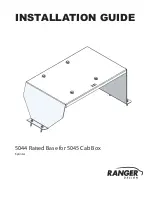In order for your helmet to function properly, the chinstrap must always be securely fastened while in use. With the chinstrap
fastened, it should not be possible to remove the helmet from your head by pulling up at the center rear. Check periodically to
see that the vibration has not caused the chinstrap to loosen. Just give a little tug to make sure it is still tight.
To securely fasten the D-ring retention system, thread the end of the chinstrap through the D-rings only as shown in the
diagram below. Pull on the loose end of the strap until the chinstrap is tight under your chin. Fasten the female snap of the
chinstrap to the male snap to secure the loose end of the chinstrap after the chinstrap is securely fastened and tightened. The
only function of the snap fastener on the end of the chinstrap is to keep it from flapping in the air stream. It is not part of the
retention system and should not be used independently without passing the chinstrap through the D-rings and then tightening
the chinstrap as illustrated below.
To release the D-ring retention system, unsnap the loose end of the chinstrap from its fastener. Then pull on the red flag
attached to the end of the lower D-ring to loosen the strap. Once loose, feed the end of the strap back through the D-rings to
fully release the chinstrap.
PLEASE MAKE SURE THAT THE CHINSTRAP IS FASTENED AS INSTRUCTED ABOVE. FAILURE TO DO SO MAY RESULT IN FATAL INJURY.
CHINSTRAP
SAFETY WARNING: Do not rely on the snap to secure the helmet. The snap is provided only to prevent the strap from flapping in
the air. Fasten the retention system only as shown in this illustration.
07
08
[SAFETY WARNING]: To reduce the risk of serious injury or death, always use your helmet correctly.
• Never adjust your helmet or helmet accessories while riding – Only make helmet adjustments when stopped.
• Never drop your helmet – Dropping your helmet may crack the shell or damage the protective foam. The damage may not
be visible. Your helmet is only designed for ONE impact. Refer to “REPLACEMENT RECOMMENDATION” for more information.
• Never wear anything between your head and your helmet – This may reduce the effectiveness of your helmet.
• Never hang or hook your helmet on anything including mirror stalks, handlebars, or sissy bars – Doing so may cause damage
to the helmet protective foam or liner.
• Never use insect repellent on or around your helmet – Insect repellant may damage your helmet’s visor, shell, protective
foam, or other components.
• Never expose helmet to gasoline or gasoline fumes – Gasoline may damage your helmet’s visor, shell, protective foam, or
other components.
USING YOUR HELMET CORRECTLY
[SAFETY WARNING]: To reduce the risk of serious injury or death and to help prevent damage to your helmet:
• Check the shield and shield ratchet – retighten shield ratchet screws if necessary. Be sure not to over- tighten any screws.
Plastic base plate screws can break and aluminum screws can strip the screw sleeves if over-tightened.
• Check for helmet damage. If your helmet is damaged or cracked, stop using it immediately. See “REPLACEMENT
RECOMMENDATION” section for further information. If your helmet has been dropped, you may not be able to
see the damage.
• Check for worn or damaged parts. Plastic components may wear out over time. If you find worn or damaged parts, replace
them or purchase a new helmet. For a complete listing of helmet replacement parts and accessories including liners, cheek-
pads, side-plates, breath deflectors, etc. visit us at WWW.RIDEICON.COM
• Make sure that the liner and cheek pads are properly in place and that the chinstrap system is secured.
INSPECTING YOUR HELMET BEFORE EVERY USE
Содержание AIRFORM Series
Страница 10: ......


















